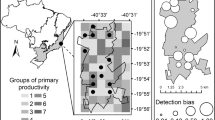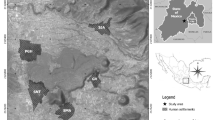Abstract
We quantitatively evaluated the effects of landscape factors on the distribution of symptomatic raccoon dogs with sarcoptic mange along an urban gradient. We used 246 camera traps (182 traps from April 2005 to December 2006; 64 traps from September 2009 to October 2010) to record the occurrence of asymptomatic and symptomatic raccoon dogs at 21 survey sites along an urban–rural gradient in the Tama Hills area of Tokyo. Each occurrence was explained in terms of the surrounding forest, agricultural, and grassland areas and additional factors (i.e., seasonal variations and survey methods) at various spatial scales using a generalized additive mixed model (GAMM). In our analysis, a 1000-m radius was identified as the important spatial scale for asymptomatic and symptomatic raccoon dog occurrence. The peak of the predicted occurrence probability of asymptomatic raccoon dogs appeared in the intermediate forest landscape as opposed to non-forest and forest landscapes. However, a high occurrence probability of symptomatic raccoon dogs was detected in non-forest and intermediate forest landscapes (i.e., urban and suburban) as opposed to a forest landscape, presumably because of animals occurring at much higher densities in more urbanized areas. Therefore, our results suggest that human-modified landscapes play an important role in the high occurrence of sarcoptic mange in raccoon dogs.



Similar content being viewed by others
References
Alexander KA, Appel MJG (1994) African wild dogs (Lycaon pictus) endangered by a canine distemper epizootic among domestic dogs near the Masai Mara National Reserve, Kenya. Journal of Wildlife Diseases 30:481–485.
Allan BF, Keesing F, Ostfeld RS (2002) Effect of forest fragmentation on Lyme disease risk. Conservation Biology 17:267–272.
Bornstein S, Mörner T, Samuel WM (2001) Sarcoptes scabiei and sarcoptic mange. In: Parasitic Diseases of Wild Mammals, Second Edition, Samuel WM, Pybus MJ, Kocan AA (editors), Ames: Iowa State University Press, pp 107–119.
Bradley CA, Altizer S (2007) Urbanization and the ecology of wildlife diseases. Trends in Ecology and Evolution 22:95–102.
Brearley G, Rhodes J, Bradley A, Baxter G, Seabrook L, Lunney D, Liu Y, McAlpine C (2013) Wildlife disease prevalence in human-modified landscapes. Biological Reviews 88:427–442.
Bureau of Social Welfare and Public Health, Tokyo Metropolitan Government (2016) The number of registration of domestic dogs in 2014. Available: http://www.fukushihoken.metro.tokyo.jp/kankyo/aigo/dog/d_touroku/26touroku.html [accessed September 5, 2016] (in Japanese).
Curtis PD, Hadidian J (2010) Responds to human-carnivore conflicts in urban areas. In: Urban Carnivores: Ecology, Conflict, and Conservation, Gehrt SD, Riley SPD, Cypher BL (editors), Baltimore: The Johns Hopkins University Press, pp 201–211.
Deplazes P, Hegglin D, Gloor S, Romig T (2004) Wilderness in the city: the urbanization of Echinococcus multilocularis. Trends in Parasitology 20:77–84.
Dormann CF, Elith J, Bacher S, Buchmann C, Carl G, Carré G, et al. (2013) Collinearity: a review of methods to deal with it and a simulation study evaluating their performance. Ecography 36: 27–46.
Eo K-Y, Kwon O-D, Shin N-S, Shin T, Kwak D (2008) Sarcoptic mange in wild raccoon dogs (Nyctereutes procyonoides) in Korea. Journal of Zoo and Wildlife Medicine 39:671–673.
Fielding AH, Bell JF (1997) A review of methods for the assessment of prediction errors in conservation presence/absence models. Environmental Conservation 24:38 − 49.
Fischer JE, Bachmann LM, Jaeschke R (2003) A reader’s guide to the interpretation of diagnostic test properties: clinical example of sepsis. Intensive Care Medicine 29:1043–1051.
Hess G (1996) Disease in metapopulation models: implications for conservation. Ecology 77:1617–1632.
Huang J, Lu XX, Sellers JM (2007) A global comparative analysis of urban form: applying spatial metrics and remote sensing. Landscape and Urban Planning 82:184–197.
Ikeda H (1983) Development of young and parental care of the raccoon dog Nyctereutes procyonoides viverrinus TEMMINCK, in captivity. The Journal of the Mammalogical Society of Japan 9: 229–236.
Ikeda H (1984) Raccoon dog scent marking by scats and its significance in social behavior. Journal of Ethology 2:77–84.
Iwasaki K, Saito MU, Sako T, Koizumi R, Teduka M, Kaneko Y (2017) Population estimation of raccoon dogs in the Akasaka Imperial Grounds using camera trap. Journal of Field Science (in Japanese with English summary).
Kauhala K, Holmala K (2006) Contact rate and risk of rabies spread between medium-sized carnivores in southeast Finland. Annales Zoologici Fennici 43:348–357.
Kauhala K, Kowalczyk R (2011) Invasion of the raccoon dog Nyctereutes procyonoides in Europe: history of colonization, features behind its success, and threats to native fauna. Current Zoology 57:584–598.
Kido N, Itabashi M, Takahashi M, Futami M (2013) Epidemiology of sarcoptic mange in free-ranging raccoon dogs (Nyctereutes procyonoides) in Yokohama, Japan. Veterinary Parasitology 191:102–107.
Kołodziej-Sobocińska M, Zalewski A, Kowalczyk R (2014) Sarcoptic mange vulnerability in carnivores of the Białowieża Primeval Forest, Poland: underlying determinant factors. Ecological Research 29:237–244.
Mackenstedt U, Jenkins D, Romig T (2015) The role of wildlife in the transmission of parasitic zoonoses in peri-urban and urban areas. International Journal for Parasitology: Parasites and Wildlife 4:71–79.
Martin RW, Handasyde KA, Skerratt LF (1998) Current distribution of sarcoptic mange in wombats. Australian Veterinary Journal 76:411–414.
Matsumoto I, Takahashi K, Yamane T, Yamane Y, Okano T, Asano M (2011) Sarcoptic mange in wild raccoon dogs in western and central Tottori Prefecture. Journal of Animal Clinical Medicine 20:13–17 (in Japanese with English summary).
Matsuo N, Taniguchi H, Ohtaki N (2015) A family case of animal scabies due to a pet dog probably transmitted by wild raccoon dog. Japanese Journal of Clinical Dermatology 69:431–434 (in Japanese).
McCallum H, Dobson A (2002) Disease, habitat fragmentation and conservation. Proceedings of the Royal Society of London B 269:2041–2049.
Ministry of Environment, Japan (2004–2012) Sixth and Seventh National Surveys of the Natural Environment, Yamanashi: Ministry of the Environment. Available: http://www.vegetation.jp/ [accessed January 18, 2016].
Mörner T (1992) Sarcoptic mange in Swedish wildlife. Revue scientifique et technique (International Office of Epizootics) 11:1115–1121.
Ninomiya H, Ogata M (2005) Sarcoptic mange in free-ranging raccoon dogs (Nyctereutes procyonoides) in Japan. Veterinary Dermatology 16:177–182.
Oleaga Á, Casais R, Balseiro A, Espí A, Llaneza L, Hartasánchez A, Gortázar C (2011) New techniques for an old disease: sarcoptic mange in the Iberian wolf. Veterinary Parasitology 181:255–266.
Pence DB, Ueckermann E (2002) Sarcoptic mange in wildlife. Revue scientifique et technique (International Office of Epizootics) 21:385–398.
Plowright RK, Sokolow SH, Gorman ME, Daszak P, Foley JE (2008) Causal inference in disease ecology: investigating ecological drivers of disease emergence. Frontiers in Ecology and Evolution 6:420–429.
R Core Team (2015). R: A Language and Environment for Statistical Computing, Vienna: R Foundation for Statistical Computing, Available: http://www.R-project.org/ [accessed January 18, 2016].
Riley SPD, Foley J, Chomel B (2004) Exposure to feline and canine pathogens in bobcats and gray foxes in urban and rural zones of a national park in California. Journal of Wildlife Diseases 40:11–22.
Saeki M (2008) Ecology of animals inhabiting a “satoyama” landscape: raccoon dogs. In: Middle-, and Large-sized Mammals including Primates (Mammalogy in Japan 2), Takatsuki S, Yamagiwa J (editors), Tokyo: University of Tokyo Press, pp 321–345.
Saeki M (2015) Nyctereutes procyonoides (Gray, 1834). In: The Wild Mammals of Japan, Second Edition, Ohdachi SD, Ishibashi Y, Iwasa MA, Fukui D, Saitoh T (editors), Kyoto: SHOUKADOH Book Sellers, pp 224–225 (in Japanese).
Saito M, Koike F (2009) The importance of past and present landscape for Japanese hares Lepus brachyurus along a rural-urban gradient. Acta Theriologica 54: 363–370.
Saito M, Koike F (2013) Distribution of wild mammal assemblages along an urban–rural–forest landscape gradient in warm-temperate East Asia. PLoS ONE 8:e65464.
Saito MU, Furukawa T, Koyanagi TF (2016) Time-delayed response of Japanese hare distribution to landscape change along an urban gradient. Journal of Mammalogy 97:1451–1460. doi:10.1093/jmammal/gyw085
Saito MU, Koike F (2015) Trait-dependent changes in assemblages of mid-sized and large mammals along an Asian urban gradient. Acta Oecologica 67:34–39.
Šálek M, Drahníková L, Tkadlec E (2015) Changes in home range sizes and population densities of carnivore species along the natural to urban habitat gradient. Mammal Review 45:1–14.
Soulsbury CD, White PC (2015) Human-wildlife interactions in urban areas: a review of conflicts, benefits and opportunities. Wildlife Research 42:541–553.
Sonoda Y, Kuramoto N (2008) Effect of forest fragmentation on species composition of non-flying mammals in the Tama hill and Kanto mountain region. Ecology and Civil Engineering 11:41–49 (in Japanese with English summary).
Smith KF, Acevedo-Whitehouse K, Pedersen AB (2009) The role of infectious diseases in biological conservation. Animal Conservation 12:1–12.
Sutor A, Schwarz S, Conraths FJ (2014) The biological potential of the raccoon dog (Nyctereutes procyonoides, Gray 1834) as an invasive species in Europe—new risks for disease spread? Acta Theriologica 59:49–59.
Suzán G, Ceballos G (2005) The role of feral mammals on wildlife infectious disease prevalence in two nature reserves within Mexico City limits. Journal of Zoo and Wildlife Medicine 36:479–484.
Tracey JA, Bevins SN, WoudeSV, Crooks KR (2014) An agent-based movement model to assess the impact of landscape fragmentation on disease transmission. Ecosphere 5:119.
Uraguchi K, Ueno M, Iijima H, Saitoh T (2014) Demographic analyses of a fox population suffering from sarcoptic mange. Journal of Wildlife Management 78:1356–1371.
White PCL, Harris S, Smith GC (1995) Fox contact behaviour and rabies spread: a model for the estimation of contact probabilities between urban foxes at different population densities and its implications for rabies control in Britain. Journal of Applied Ecology 32:693–706.
Yachimori S, Yamamoto Y, Takada T, Kikkawa Y, Imai K (1997) Estimation of the family relation of the raccoon dogs on the basis of resting site utilization patterns and molecular biological approach. Mammalian Science 36:153-164 (in Japanese with English summary).
Yamamoto I (1984) Latrine utilization and feces recognition in the raccoon dog, Nyctereutes procyonoides. Journal of Ethology 2:47–54.
Yamamoto S, Takahashi M, Nogami S (1998) Scabies in wild raccoon dogs, Nyctereutes procyonoides at the Tomioka-Kanra district in Gunma Prefecture, Japan. Medical Entomology and Zoology 49:217–222 (in Japanese with English summary).
Yamamoto Y (1993) Home range and diel activity pattern of the raccoon dog, Nyctereutes procyonoides viverrinus, in Kawasaki. Bulletin of the Kawasaki Municipal Science Museum for Youth (4):7–12 (in Japanese).
Yamamoto Y, Kinoshita A (1994) Food comparison of the raccoon dog Nyctereutes procyonoides viverrinus in Kawasaki. Bulletin of the Kawasaki Municipal Science Museum for Youth (5):29–34 (in Japanese).
Yamamoto Y, Ootuki T, Seino S (1996) Habitat utilization of the raccoon dog Nyctereutes procyonoides viverrinus in suburban area. Bulletin of the Kawasaki Municipal Science Museum for Youth (7):19–26 (in Japanese).
Yamamoto Y, Terao K, Horiguchi T, Morita M, Yachimori S (1994) Home range and dispersal of the raccoon dog (Nyctereutes procyonoides viverrinus) in Mt. Nyugasa, Nagano Prefecture, Japan. Natural Environmental Science Research 7:53–61 (in Japanese with English summary).
Acknowledgements
We thank the administrative offices of each green area for permitting the field surveys. This study was supported in part by the JSPS Global COE (Centers of Excellence) Program “Global eco-risk Management from Asian Viewpoints,” Joint Research Program C of the Research Institute of Environment and Information Sciences, Yokohama National University, and JSPS KAKENHI [Grant Number 15J08830].
Author information
Authors and Affiliations
Corresponding author
Rights and permissions
About this article
Cite this article
Saito, M.U., Sonoda, Y. Symptomatic Raccoon Dogs and Sarcoptic Mange Along an Urban Gradient. EcoHealth 14, 318–328 (2017). https://doi.org/10.1007/s10393-017-1233-1
Received:
Revised:
Accepted:
Published:
Issue Date:
DOI: https://doi.org/10.1007/s10393-017-1233-1




